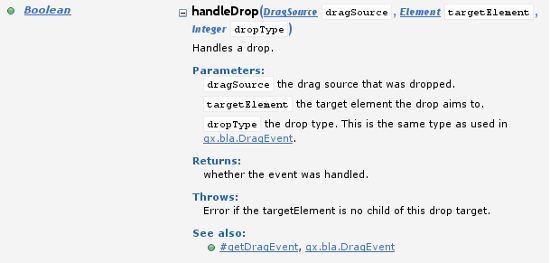Writing API Documentation¶
For documenting the qooxdoo API special comments in the source code (so-called "doc comments") are used. The doc comments in qooxdoo are similar to JSDoc comments or Javadoc comments. To account for some qooxdoo specific needs there are certain differences to the two systems mentioned above. For a complete treatment of the syntax see the JSDoc reference.
An introductory example¶
Doc comments are specially formatted comment blocks enclosed by /** and */. A typical use case is to put them in front of a method definition. You start with a general description of the method, and then add sections that start with @ followed by a special key that describes e.g. a parameter or the return type of the method. Here is an example:
/**
* Shows a message to the user.
*
* @param text {string} the message to show.
*/
showMessage : function(text) {
...
}
The @param attribute entry describes the parameter text. Description texts may also include markup for highlighting and structure.
Here is a longer example that covers an entire class file:
/**
* General class description.
*/
qx.Class.define("mypackage.MyClass",
{
extend : blubb.MySuperClass,
/**
* Constructor description.
*
* @param param1 {Integer} description of first parameter\
*/
construct : function(param1) {
...
}
});
properties :
{
/** Property definitions. */
"myProperty" :
{
check : "Number",
init : 0
}
},
members :
{
/** Method description */
myMethod : function(bla, blubb)
{
...
}
},
statics :
{
/** Static method description */
myStaticMethod : function(bla, blubb)
{
...
},
/** Constant description */
MY_CONSTANT : 100
},
The class description is taken as the first comment in the file which starts with /**. Therefore if you have a comment at the start of the file which has a first line of /**********, that will be taken as the class description, overriding any comment above the class itself. Therefore use /* ********* or /* ========== etc.
Advanced Doc Comments¶
Here is a more advanced example of a method documentation block that uses more @ keys to provide structured information about the method.
/**
* Handles a drop.
*
* @param dragSource {qx.bla.DragSource} the drag source that was dropped.
* @param targetElement {Element} the target element the drop aims to.
* @param dropType {Integer ? null} the drop type. This is the same type
* as used in {@link qx.bla.DragEvent}.
* @return {Boolean} whether the event was handled.
* @throws {Error} if the targetElement is no child of this drop target.
*
* @see #getDragEvent
* @see qx.bla.DragEvent
*/
handleDrop : function(dragSource, targetElement, dropType) {
...
}
This will render in the Apiviewer similarly to this:

As mentioned above the JSDoc reference has the complete list of possible section keys and markup possibilities.
Package documentation¶
While documenting a class files where JSDoc comments are interleaved with the class code seems straight forward, this is not so obvious if you want to provide documentation for a package, i.e. a collection of classes under a common namespace (like qx.ui.core, qx.util, etc.).
In order to fill this gap you can add a __init__.js file to the package. This file should contain only a single JSDoc comment that describes the package as a whole. These files are then scanned during a generate.py api run and the documentation is inserted at the package nodes, together with a list of classes of the corresponding package, in the documentation tree. See the API documentation for the framework packages as examples.